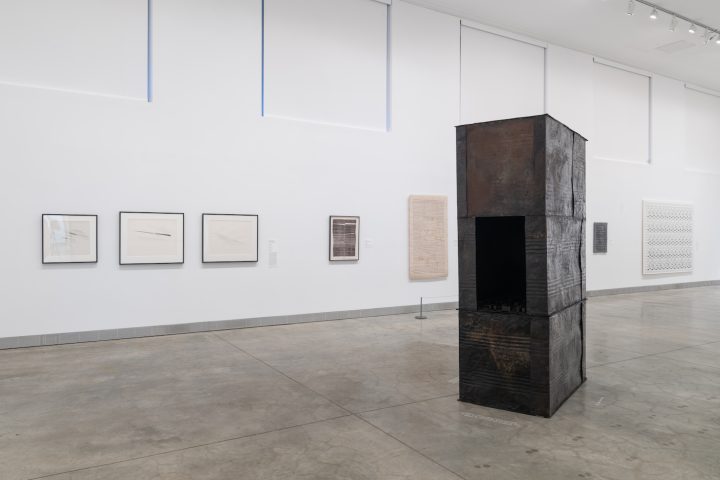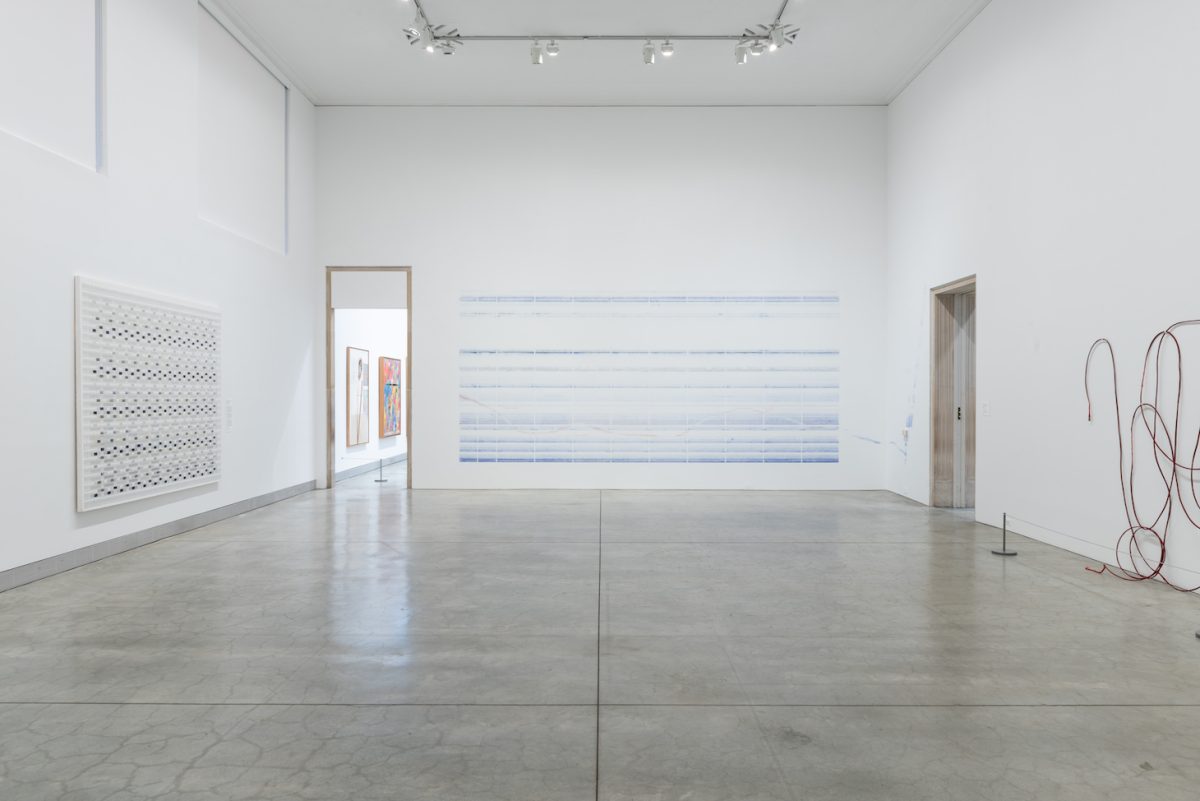
PHILADELPHIA — One of the most compelling artworks in Fault Lines, an exhibition of contemporary abstraction by South Asian artists at the Philadelphia Museum of Art, is Sheela Gowda’s “A Blanket and the Sky” (2004). The artist, who lives in Bangalore, India, has built a three-level rectangular structure of flattened tar drums. From a distance, the dark, minimalist structure imposes itself on the room and suggests it may have held unimaginable horrors before arriving at the museum.
But upon stepping closer, the work disarms the viewer with an invitation on the floor in front of it that reads: “Careful, sharp edges. You’re welcome to poke your head inside, but please do not touch the sculpture.” What should viewers expect based on this invitation? On a narrow side, there is an opening in the middle level (roughly the height of an adult’s torso). The space inside is larger than I had guessed. Small, raised pieces of bent metal create the impression of slum housing in miniature. The flat spaces between the houses look like roads. Little bits of light flicker across the top of this scene and against the interior walls of the sculpture. Look up, and you see Gowda has poked tiny holes in the top, recreating the wonder of the night sky.
The other opening is lower to the ground. Inside is a blanket on the floor. This space could hold a small child or an adult curled up tight, yet nothing about it is truly comforting. “A Blanket and the Sky” has stayed with me since seeing the show. At several points, I had to adapt my line of thought to a new feature of the work, whether it was the imposing nature of the structure, the invitation to poke my head inside, or the small, cramped space with the blanket. The artist has a remarkable ability to layer her social and political commentary.

Gowda frequently uses everyday materials from her local community to reflect the difficulties faced by those in developing countries. Her work resists easy interpretations. As she put it in the 2007 exhibition catalogue for a solo show at Bose Pacia gallery, “If my work gets read as beautiful alone it would be inadequate. It would be a reading of the surface markers alone because the underlying layers are dark.” “A Blanket and the Sky” embodies her comments.
Much of the work in this exhibition also echoes Gowda’s ideas. All five artists are devoted to their process and materials while also maintaining an awareness of the world outside of their studios. None of the work is solipsistic or “art for art’s sake”; the artists seem driven to apply the materials and methods of abstraction to concrete issues. This is not to say that the work is didactic: much of it is characterized by questions rather than answers about how abstraction can be applied to significant social or political issues.
Abstract art, particularly American abstraction, has long been dominated by the narrow idea that it should avoid content in favor of materials, composition, and perhaps the interior world of the artist. Abstract Expressionism defined this line of thought. Without doubt, much of that work opened up new ways to make and think about art. But in recent years, artists, mostly in Asia or otherwise outside the Euro-American art world, have produced abstract work that is unafraid of content or social issues.

Nasreen Mohamedi (1937-1990), who was active in Baroda (present day Vadodara), India, started exhibiting minimalist abstract work in the 1960s and was closely associated with the abstract artists V. S. Gaitonde and Tyeb Mehta, who became her mentors. Her extensive travel to Europe and the United States also exposed her to Western models, but it’s not always easy to tell how, when, or if at all those influences show up in the work. Her pared down, minimalist approach stood in sharp contrast to the representative methods of art making in India at the time.
Fault Lines includes three drawings in ink and pencil on paper by Mohamedi dating from the mid-1980s. Each work consists of forms suspended as intersecting planes. The mathematical precision of her work derives its influence from repetitions found within Mughal architecture and Indian classical music. The lines are exceptionally delicate, making the drawings feel as if they could drift off the page into the gallery.
These Cities Blotted into Wilderness (Adrienne Rich after Ghalib) (2003), a set of woodcuts by the Indian-born artist Zarina, reflects the delicacy of Mohamedi’s line. Each piece depicts several cities impacted by global conflict. Zarina, whose family was uprooted and relocated to Pakistan after the 1947 partition of India along religious and ethnic lines, often returned to this theme. After years of travel, she settled in New York, where she remained active until her death from complications related to Alzheimer’s in April 2020.

The side by side placement of “Baghdad” and “Kabul,” as well as her portrayal of “New York” as a predominately black background with two imperfect and narrow vertical white lines representing the World Trade Center, took on a renewed gravity in 2021. Zarina’s work makes the viewer aware of these geographic sites as places with their own senses of space, sometimes defined by features in the land or, quite often, shaped by human hands. Without images of battle scenes or people suffering, it becomes the viewer’s responsibility to understand why the artist has chosen these cities as her subjects. The series title suggests the conflicts in these cities as a form of extermination. They are being stained in unalterable ways. And all of this blotting stems from colonialism and its aftereffects, and the misguided attempts by other nations to colonize under the guise of repairing what’s wrong.
The works in Fault Lines, which also includes minimalist abstract paintings by Tanya Goel and Prabhavathi Meppayil, prove that abstraction need not be confined to the inner life of the artist. It’s possible and perhaps necessary at this point in human history to link an exploration of materials with events and conflicts in the world. Contemporary life, rather than providing a clearer path forward, is actually becoming more fragmented and kaleidoscopic. The exhibition, in its title, acknowledges this fact.
Fault Lines: Contemporary Abstraction by Artists from South Asia continues at the Philadelphia Museum of Art (2600 Benjamin Franklin Parkway, Philadelphia, Pennsylvania) through April 10, 2022.
0 Commentaires